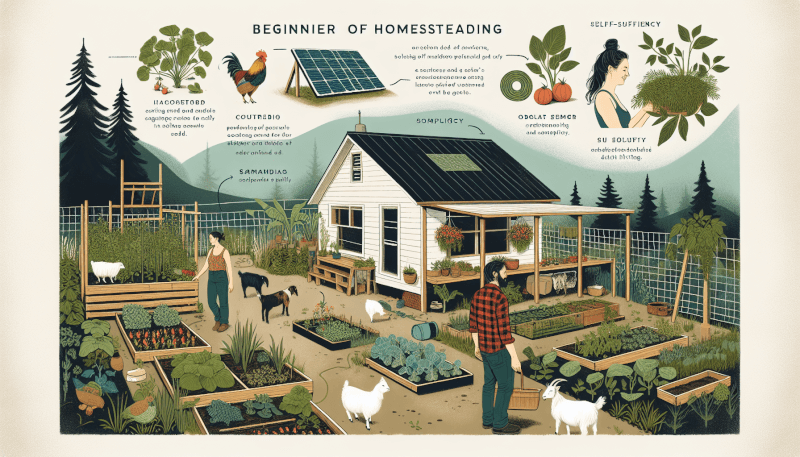Imagine a life where you are in control of your own food production, where the rhythm of your days is guided by the sun and the seasons. Homesteading, an age-old way of living, is making a comeback as more people seek a simpler, more sustainable lifestyle. If you’re a beginner eager to embark on this rewarding journey, look no further. This ultimate guide is packed with tips, advice, and inspiration to help you take your first steps towards homesteading bliss. From growing your own vegetables to raising chickens, this article will equip you with all the essential knowledge you need to start your own homestead. So grab your gardening gloves and get ready to embrace the joys of homesteading.
What is Homesteading?
The Definition of Homesteading
Homesteading is a lifestyle that embraces self-sufficiency, sustainability, and a return to a simpler way of living. It involves creating a home and a livelihood on a piece of land, often located in rural areas. Homesteaders aim to produce their own food, generate their own energy, and rely less on external resources. It is a way of taking control of your life and becoming more connected to the land.
A Brief History of Homesteading
Homesteading has a rich and storied history, dating back to the Homestead Act of 1862 in the United States. This act offered 160 acres of land to any citizen or immigrant who was willing to settle in the rural areas of the country and improve the land by cultivating crops or building homes. Thousands of people took advantage of this opportunity and began their journey towards self-sufficiency and land ownership. Homesteading became a symbol of the American dream and a way for individuals and families to create a better life for themselves.
Benefits of Homesteading
Self-Sufficiency and Sustainable Living
One of the primary benefits of homesteading is the ability to become self-sufficient. By growing your own food, raising livestock, and generating your own energy, you can reduce your reliance on external resources and become more resilient in the face of economic or environmental challenges. Homesteading also promotes sustainable living by encouraging the use of renewable resources, organic farming practices, and responsible consumption.
Reduced Expenses and Debt
When you embrace the homesteading lifestyle, you have the opportunity to significantly reduce your expenses and debt. By producing your own food, you can save money on groceries and eat healthier, fresher meals. Generating your own energy through solar or wind power can also cut down on utility bills. Additionally, many homesteaders embrace simple living and minimalism, which leads to reduced spending and less reliance on consumer goods.
Health and Well-being
Homesteading can have a positive impact on your physical and mental health. Engaging in physical labor, such as gardening, livestock care, and building maintenance, provides exercise and promotes a healthy, active lifestyle. The sense of accomplishment and connection with the land can also improve mental well-being. Being part of nature and embracing a slower pace of life can reduce stress levels and foster a sense of peace and contentment.

Choosing and Purchasing Homestead Land
Researching Potential Locations
Before purchasing homestead land, it is crucial to thoroughly research potential locations. Consider factors such as climate, soil quality, water availability, and local regulations. Look for areas that have a favorable growing season and a supportive community of homesteaders. Additionally, assess the proximity to essential amenities like schools, healthcare facilities, and stores to ensure a well-rounded and convenient lifestyle.
Considerations for Choosing the Right Property
When choosing the right property for your homestead, there are several considerations to keep in mind. Look for land that is suitable for your intended activities, whether it be gardening, livestock raising, or alternative energy production. Accessibility to transportation routes and markets is important for ease of selling and transporting goods. Take into account the size of the property, available infrastructure, and any potential environmental concerns or restrictions.
Budgeting and Financing
Once you have identified a suitable property, it is essential to budget and plan for the expenses associated with purchasing and developing your homestead. Consider the cost of land, infrastructure development, equipment, and any additional investments required for your specific goals. Explore financing options such as loans, grants, or crowdfunding to help fund your homestead dream. Developing a detailed financial plan will help ensure a smooth transition and successful homesteading journey.
Homestead Design and Infrastructure
Creating a Homestead Master Plan
Before you break ground on your homestead, it is advisable to create a master plan that outlines your goals and the design of your property. Consider factors such as the layout of your garden, the location and size of livestock enclosures, and the placement of structures such as your home, barn, or tool shed. A well-thought-out master plan will maximize efficiency and productivity while ensuring a harmonious integration of all elements of your homestead.
Zoning and Building Codes
When designing your homestead, it is important to familiarize yourself with local zoning regulations and building codes. These laws dictate what you can build on your property and may include restrictions on the size and height of structures, setbacks from property lines, and environmental considerations. Following these guidelines will help you avoid legal issues and ensure that your homestead is safe and compliant.
Structures and Utilities
Creating the necessary structures and utilities on your homestead is a crucial aspect of designing your property. Depending on your needs and goals, you may need to construct a home, barn, greenhouse, or storage facilities. Consider the materials, design, and functionality of these structures to optimize their use and minimize maintenance. Additionally, explore options for alternative energy sources such as solar panels or wind turbines to reduce your reliance on the grid.

Homesteading Skills and Knowledge
Gardening and Food Preservation
Gardening is a fundamental skill for any homesteader. Learn about soil composition, plant types, and seasons to ensure a successful harvest. Master techniques such as companion planting, crop rotation, and natural pest control to maximize yields and promote a healthy garden ecosystem. In addition to growing your own food, it is important to learn food preservation methods such as canning, dehydrating, and fermenting to maintain a steady food supply throughout the year.
Raising Livestock
Raising livestock is an integral part of many homesteads. Whether you choose to keep chickens for eggs, goats for milk, or cows for meat, it is crucial to understand the specific needs and requirements of each animal. Learn about proper housing, feeding, and healthcare practices to ensure the well-being of your livestock. Embrace sustainable and ethical animal husbandry practices, such as rotational grazing and natural remedies, to create a healthy and stress-free environment for your animals.
Basic Carpentry and Repairs
Homesteaders often find themselves in need of basic carpentry and repair skills. Learning how to build or repair structures, fences, and tools will save you money and provide a sense of accomplishment. Invest in quality tools and learn how to maintain them properly. Practice basic woodworking skills such as measuring, cutting, and joining materials. With these skills, you will be able to handle a wide range of projects on your homestead with confidence.
Alternative Energy Systems
Harnessing alternative energy sources is not only environmentally friendly but also vital for off-grid living. Explore options such as solar power systems, wind turbines, or hydroelectric power to generate electricity for your homestead. Understand the principles of each system and assess their feasibility based on your geographical location and energy needs. Investing in alternative energy systems can significantly reduce your reliance on traditional energy sources and lower your carbon footprint.
First Aid and Emergency Preparedness
Living on a homestead can sometimes present unique challenges and risks. It is essential to have basic first aid knowledge and emergency preparedness skills to protect yourself and others in case of an accident or unforeseen event. Learn how to administer first aid for common injuries and illnesses and create a well-stocked first aid kit. Additionally, develop an emergency plan that includes evacuation routes, contact information for emergency services, and strategies for handling natural disasters or other emergencies.
Managing Finances and Resources
Budgeting and Financial Planning
Successful homesteading requires careful budgeting and financial planning. Create a detailed budget that accounts for both income and expenses, including the costs of land, infrastructure development, and ongoing maintenance. Consider diverse income sources such as selling excess produce, homemade crafts, or services related to your homesteading skills. Regularly review and adjust your budget to ensure your financial stability and the sustainability of your homestead.
Income Generating Activities
Homesteaders often find creative ways to generate income while living sustainably. Consider activities such as selling organic produce, eggs, or honey at local markets or through community-supported agriculture (CSA) programs. Explore value-added products such as homemade jams, soaps, or crafts that can be sold online or at local stores. Additionally, offer workshops or educational services to share your homesteading knowledge and skills with others, creating a sustainable income stream.
Resource Management and Conservation
Responsible resource management is a fundamental aspect of homesteading. Aim to minimize waste, conserve water, and practice sustainable land management techniques. Implement strategies such as rainwater harvesting, composting, and recycling to reduce your ecological footprint. Establish a system for monitoring and managing your resources, including energy consumption, water usage, and waste production. By adopting these practices, you can ensure the long-term sustainability of your homestead.

Growing and Preserving Food on Your Homestead
Choosing Crops and Garden Layout
Selecting the right crops and planning your garden layout are crucial for a successful harvest. Research which crops are best suited to your climate, soil type, and personal preferences. Consider crop rotation and companion planting to promote soil health and pest control. When planning your garden layout, take into account factors such as sun exposure, soil drainage, and the needs of each specific crop. Maximize space utilization and optimize the number of harvests per season to provide an abundance of fresh produce for your homestead.
Organic Gardening Methods
Organic gardening is a cornerstone of sustainable homesteading. Foster a healthy ecosystem by avoiding artificial fertilizers, synthetic pesticides, and genetically modified organisms (GMOs). Instead, embrace organic fertilizers, natural pest control methods, and heirloom seeds. Learn about composting, vermicomposting, and natural soil amendments to enrich the soil and provide essential nutrients to your plants. By adhering to organic gardening practices, you can enjoy chemical-free, nutritious produce while being kind to the environment.
Harvesting and Food Preservation Techniques
Once your crops are ripe and ready for harvest, it is important to know the proper techniques for harvesting and food preservation. Harvest fruits and vegetables at the peak of their ripeness for optimal flavor and nutritional value. Learn the proper methods for storing and preserving different types of produce, whether it be canning, freezing, or dehydrating. Experiment with homemade jams, pickles, and fermented vegetables to extend the shelf life of your harvest and enjoy the flavors of your garden all year round.
Raising Livestock and Poultry for Self-Sustainability
Selecting the Right Livestock for Your Homestead
Choosing the right livestock for your homestead depends on various factors, including available space, resources, and personal preferences. Consider animals such as chickens for eggs, rabbits for meat, or goats for milk. Research the specific needs and requirements of each species and evaluate if you have the necessary space and resources to accommodate them. Selecting livestock that aligns with your goals and capabilities will ensure a successful and enjoyable homesteading experience.
Sustainable Animal Husbandry Practices
Raising livestock in a sustainable and ethical manner is essential for successful homesteading. Provide your animals with adequate housing, access to pasture or forage, and a balanced diet. Embrace rotational grazing to promote healthy pasture growth and minimize soil erosion. Use natural remedies and preventative measures to ensure the well-being of your animals, reducing the need for antibiotics or other chemicals. By prioritizing sustainable animal husbandry practices, you can create a harmonious relationship between your livestock and the land.
Breeding, Raising, and Processing
If you choose to breed and raise livestock on your homestead, it is essential to understand the processes involved. Learn about breeding techniques, such as natural mating or artificial insemination, depending on the species. Prepare for the responsibilities of raising young animals, including proper nutrition, healthcare, and socialization. If your goal is to produce meat, learn about humane and stress-free processing methods or consider partnering with local butchers who specialize in small-scale operations. Understanding these processes will ensure the success and sustainability of your livestock endeavors.

Off-Grid Living and Alternative Energy Sources
Understanding Off-Grid Living
Off-grid living is the epitome of self-sufficiency and sustainability. It involves disconnecting from traditional utility services and generating your own power, heat, and water. This lifestyle choice requires careful planning and investment in alternative energy sources, such as solar power systems, wind turbines, or hydroelectric power. It also necessitates water conservation, rainwater harvesting, and responsible waste management. Off-grid living empowers you to take control of your energy consumption and reduce your impact on the environment.
Solar Power Systems
Solar power systems are a popular and practical choice for off-grid living. Understanding the basics of solar energy, including how panels capture sunlight and convert it into electricity, will help you design an efficient and effective system for your homestead. Assess your energy needs, calculate your solar potential based on geographic location, and determine the optimal size of your solar array and battery bank. With proper installation and maintenance, solar power systems can provide a reliable and sustainable source of electricity for your off-grid lifestyle.
Wind and Hydro Power
For homesteaders living in areas with reliable wind or hydro resources, harnessing these alternative energy sources can provide a viable off-grid solution. Wind turbines can generate electricity by capturing the energy from the wind, while hydroelectric power systems utilize flowing water to produce power. Assess the wind or water resources on your property, consider the size and number of turbines or generators necessary, and consult with experts to ensure the safe and efficient installation of these systems. Wind and hydro power can supplement or even replace other energy sources, allowing you to truly embrace the off-grid lifestyle.
Building a Supportive Homesteading Community
Networking with like-minded Homesteaders
Building a supportive community is an invaluable aspect of the homesteading experience. Seek out like-minded homesteaders in your area through local community groups, online forums, or social media platforms. Attend workshops, classes, or events where you can connect with others who share your passion for self-sufficiency and sustainability. By networking with experienced homesteaders, you can gain valuable knowledge, share resources, and foster lasting friendships that will enhance and enrich your homesteading journey.
Bartering and Sharing Resources
Bartering and sharing resources among fellow homesteaders is a common practice that fosters a sense of community and self-reliance. Exchange surplus produce, homemade goods, or services with your neighbors to meet your needs and reduce waste. Consider creating a community tool lending library, where members can borrow and share tools for various projects. By participating in resource sharing and bartering, you can build stronger relationships and create a supportive network of individuals who are invested in each other’s success.
Learning from Experienced Homesteaders
Experienced homesteaders have a wealth of knowledge and wisdom to share. Take advantage of their expertise by seeking out mentorship opportunities or attending workshops and classes. Learn from their successes and failures, ask questions, and observe their techniques. By learning from those who have already walked the path of homesteading, you can avoid common pitfalls, gain valuable insights, and accelerate your learning curve. Embrace the camaraderie and willingness to help within the homesteading community, and remember that everyone started as a beginner at some point.
In conclusion, homesteading offers a way to reconnect with the land, embrace self-sufficiency, and contribute to a more sustainable future. Through careful planning, acquisition of essential skills, and fostering a supportive community, anyone can embark on a successful homesteading journey. Whether you are looking to reduce expenses, improve your health and well-being, or simply enjoy a simpler way of life, homesteading provides a roadmap to a fulfilling and enriching lifestyle. So, roll up your sleeves, embrace the adventure, and start building your dream homestead today!



